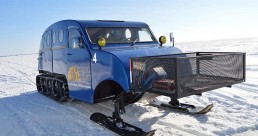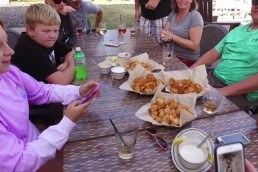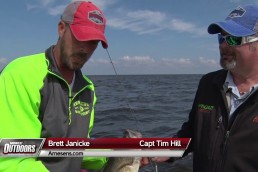Icing the Big Crappies of Lake of the Woods
SHARE THIS POST
When anglers think about ice fishing Lake of the Woods, most automatically think walleyes. There is an opportunity that is off the radar screen for many ice anglers that is absolutely world class. Each winter, schools of big crappies roam structure amongst the 14,552 islands that make up a good part of the lake. These crappies can measure in excess of 15 inches and tip the scales at 2 pounds. They are big, they are beautiful and they are fun!
This body of water is big and the crappies don’t inhabit all parts of the lake. What most ice anglers do is stay at the northernmost point of the Continental United States, a detached piece of Minnesota called the Northwest Angle. This is some of the most beautiful landscape this land has to offer and amongst its beauty are a number of resorts that cater to ice anglers.
Much of the best fishing for big crappies takes place just a short distance from the NW Angle resorts into the desolate Ontario portion of Lake of the Woods. It is a good idea to use a resort guide, since it is important to know the ice that is being navigated, and it also saves time in locating fish.
When considering how to approach these big crappies, it depends upon how aggressive you want to be and of course the weather. If it is cold and your intent is to fish in a fish house and stay put, use the one-two punch: one hole for jigging and the other hole for a dead stick, which is a minnow under a bobber for the less aggressive fish.
The deadstick is effective when crappies are in a neutral mood. Set the jig and minnow about a foot off of the bottom and give it an occasional jig. Watch to see where in the water column most of the crappies are coming through and adjust your dead stick accordingly.
In the jigging hole, use your favorite crappie ice jig tipped with a minnow head or tail for starters. Dial them in, meaning, have your partner use a different jig, a different color and figure out what the fish want that given day and adjust.
Another popular choice to tip your jig with is a pink or white plastic. Use your electronics to learn how the fish are reacting and tease the fish into eating. If the fish are showing signs of being finicky, I prefer the smell of live bait.
If you are hardcore and have the proper clothing to stay warm, hole hopping or “ice trolling” can be extremely effective. Punch a number of holes in the area you are looking for crappies. Varying depth and spreading out a bit is a good idea as crappies can roam. Once you locate some fish, drill more holes in that particular area. The water is stained and the depth is usually 20 to 30 feet, thus punching some holes doesn’t seem to spook the fish.
When ice trolling, I like to use a small jigging spoon that I would normally use for walleyes. These crappies are big enough, so there is no problem for them to inhale this small spoon tipped with a piece of minnow. My go-to colors are pink, gold, glow or a combination thereof. Using a small spoon vs. a traditional lightweight crappie jig allows me to drop my lure through some slush or ice that forms on holes and allowing me to get down to the fish quicker. When covering area on the ice, I can fish quicker with a heavier lure. This is especially key when there is a nice red mark about a foot or two off of the bottom showing up on my electronics. If you have watched a nice mark disappear while you are feverishly trying to get your offering to the bottom, you know what I mean.
Are you enjoying this post?
You can be among the first to get the latest info on where to go, what to use and how to use it!
Ice trolling puts more fish on the ice. First off, I can cover a lot of area. When these fish are roaming around, I can come into contact with more fish and active fish. I walk around with my bucket. Inside I have my Vexilar, one ice rod and reel, a baggie of dead minnows and an ice scooper.
When I punch a hole, I rev the engine and pull up on the auger at the same time to clear the hole. When approaching a hole that hasn’t been fished for a while, there is usually a skim of ice over the hole. I use my boot to kick open the hole and even though the ice may not be perfectly clean, I can usually drop my spoon through the slush simply to save time. If there is a fish in the area, that fish will usually show up in a few minutes. If not, I will move to another hole.
It almost seems like I will contact one or two fish per hole and then that hole goes quiet. I have learned to move on to other holes making mental notes on what holes have produced. I will let a hole rest a while and certainly make my way back. Being able to fish faster catches me more fish.
When a fish moves into the screen to investigate my spoon, I will usually jig it a couple of times and let it sit right in front of the fish. If they do not hit it, I tease them up. While shaking my rod, I slowly reel the lure up in the water column. Often times, the fish will see that as escaping bait and start to chase the lure up, sometimes as far as 20 feet up. Don’t stop the lure. Keep it moving up the water column until the fish comes from underneath the lure and eats. If the fish stops and swims back down, lower your lure back down and repeat. Sometimes, it takes two or three times to get the fish to go. If you are not having success, change your offering.
To get stubborn fish to eat, try shaking the lure like heck and letting it sit in the strike zone. Another technique is to drop the lure on the bottom and lift it up into the strike zone. This not only causes sound that can turn fish on, it is a dinner bell to other fish in the area. It makes sense some of the bait crappies eat mimic similar behavior.
When you engage with a big crappie, don’t force them. These fish are big and their paper-thin mouths can tear. Take your time in pulling them up, and if it is a big fish, reach down into the hole to grab or scoop the fish out vs. lifting them out.
Part of the fun of fishing for these fish is the variety of fish you can run into. It is common to catch good numbers of walleyes, saugers, jumbo perch and pike while fishing for Lake of the Woods crappies. Like any big fish, it takes some years to grow crappies this big and a bit of conservation will certainly allow for good populations down the road. Many anglers are good about taking a quick picture and filling the fry pan with walleyes, saugers and perch from the day’s catch.
Working the hard water for the big, beautiful crappies leads to some incredible fishing. Crappies are good fun anytime, but having the chance for a 15-incher with a mixed bag of fish to boot makes it even better. If you have a hankering to try for a real slab, possibly one for the wall, add this adventure to your list.
MWO
SHARE THIS POST
You may also like...
Did you enjoy this post?
You can be among the first to get the latest info on where to go, what to use and how to use it!
Joe Henry
Tournament angler and licensed charter captain Joe Henry fishes and hunts the Midwest. Henry is a media member of AGLOW and writes for numerous publications, creates videos, appears on a variety of outdoor TV and radio shows and is a frequent seminar speaker. Henry is the Executive Director of Lake of the Woods Tourism.


